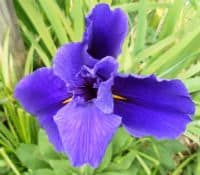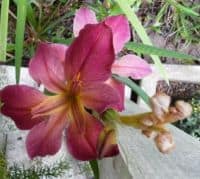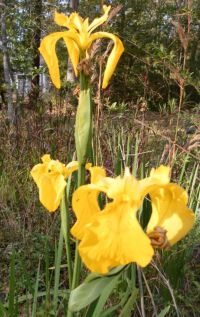
IRISES
Louisiana Iris or Swamp Iris
Native species are Iris brevicaulis, Iris fulva, Iris giganticaerulea, Iris hexagona, Iris nelsonii. These species do not cross with other groups and are known as “The Louisianas”. They bloom March through May and look great in clumps with other perennials.
Louisiana Iris come in a wide range of colors with strap-like leaves of up to three feet long and 1 to 1 and 1/2 inches wide in a fan-like shape from the base. Foliage can be soft with arching leaves or stiff upright leaves. Flower colors are blue, purple, rust red, white and yellow. Irises produce four to ten flowers per plant. The flowers are on zigzag stems. They range from two to eight inches and consist of six petals.

They give best results when grown in full sun to part shade in moist, acidic (pH of 6.5), soils with high fertility and organic matter. They do best on pond edges and in shallow water. These plants do well with other plantings but can be crowed out by aggressive plants.

Late summer or fall is the time to plant and divide these plants. Prepare beds in advance with lots of organic matter. Plants should be divided about every three years as crowded plants produce fewer blooms. Fertilize in late January or early February before bloom with a complete fertilizer or bone meal.
Yellow Flag Iris or Iris pseudacorus
Some species of Yellow Flag Iris are, Iris foetidissima with yellow and green flowers in spring with bright orange seeds in fall, Iris tectorum has blue and white flowers, make as good ground cover as it is shorter than others, and Belamcanda chinensis has orange flowers with purple spots that bloom lily-like in early summer and grows well in dry soils.

Yellow Flag Iris is not a Louisiana iris but is native to Europe and western Asia and has adapted to the conditions of the southeastern states. It thrives in wet, boggy soils & in regular garden soils in full sun to partial shade. This Iris is aggressive and may be considered invasive. It forms a dense mass after a year. It is not recommended to plant Yellow Flag Iris with other irises as they will take over.
The leaves of the yellow flag iris are pale green, erect with a thick midrib. They are one to more than five feet tall. The plant has fan shaped clusters. The flower consists of 2 bright yellow flowers of 3 inches across in the axil of the upper leaves which appear near the tip of the foliage. Flower has brown vein-like markings along the falls and blooms in spring.
Plant the rhizomes 2 feet apart and just beneath the surface of the soil. Mulch plantings with pine bark or straw when planted and throughout the season. Fertilize in early spring with an all purpose fertilizer but this is not necessary.
submitted by Karen Blackburn
